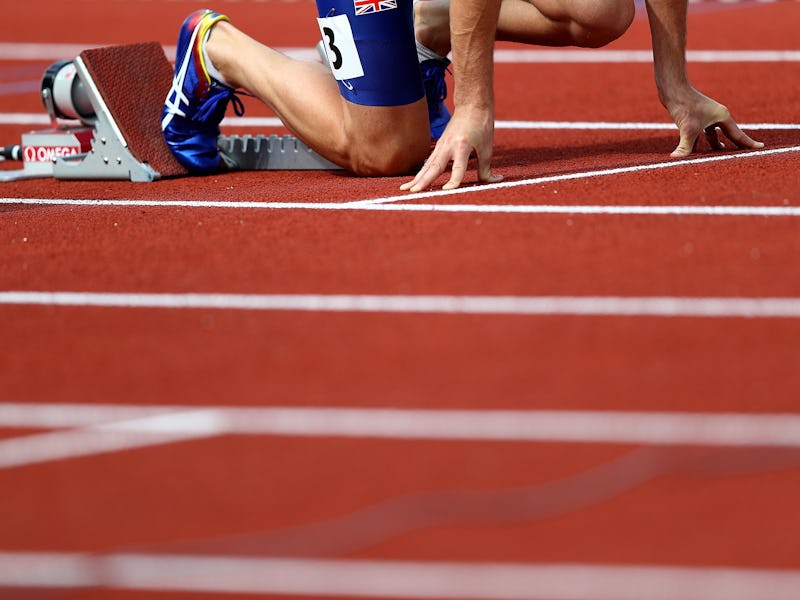The Olympics Are About Listening for Gunfire
Reaction time is the difference between the podium and a pat on the back.

On Sunday, Michael Phelps almost got the American 400-meter men’s relay team disqualified. His reaction as his teammate Caeleb Dressel hit the wall was lightning fast — almost too fast. Exactly .08 milliseconds after Dressel touched, Phelps dove. What followed was a dominating performance, but that start helped.
After the race, commentators did what commentators do when Michael Phelps swims: They talked about his form and his natural grace. He has those things (and very long arms), but he also has crazy fast reaction time and it’s almost impossible to overstate how significant that is in swimming narrowly and the Olympics generally.
How do we know reaction time is so significant? Because we’ve studied guns — and what happens when we fire them during track meets. There’s evidence to indicate that athletes who are closer to the gun do better because they hear it first and go. In a study from a couple Olympics ago published in the June 2008 issue of Medicine & Science in Sports & Exercise, researchers looked back at the Athens 2004 Games, analyzing track and field events to discover that the sprinters who were physically closer to the starter gun sound had measurably faster reaction times. Runners in the lane closest the gun responded within 160 milliseconds of the sound of the gun. Runners in all other lanes combined averaged a 175 millisecond response time.
That’s right: There is a 15 millisecond difference between the fastest reaction time and the slowest one — enough to significantly alter the course of a race. Runners routinely win sprints by that much. Phelps and the Americans won by 610 of them and it was considered decisive.
The research team of this test wanted to make sure that maybe Athens didn’t have some freak acoustic warp going on and that sprinters actually reflected an average population in terms of reaction time (arguably, the time it takes for a mere mortal to react to a gunshot should be the same as that of a sprinter, as it requires no athletic prowess); they also wanted to know if gunshot volume had a role to play in reaction times. So they took four trained sprinters and matched them up with 12 normal people to perform sprint starts at starting blocks using a recorded gunshot, then tested reaction times from a low of 80 decibels to a high of 120 decibels, amping up the volume of the gunshot as they hit the higher range.
Here’s what they found: The louder the gunshot, the faster the reaction time. In other words, the person with the best reaction time — and the best shot at a spot on the elusive medals stand — was the one not just closest to the starter gun but also hearing the loudest possible kaboom.
This isn’t entirely surprising; You’re probably going to hear the sound of a gunshot faster if you’re closer to the source than if you’re farther away. And sure, that sound might hit the eardrums of the furthest racer at almost the same time as the racer closest to the gun, but any Olympian will tell you that the blink of an eye is a significant amount of tim.
Brain training’s gotten a lot of crap over the past year for being a whole bunch of baloney — and rightfully so. But one thing trainers are increasingly incorporating into the hours at the gym for athletes who are timed for their performance — particularly in fast, short events — is focusing on speeding up athletes’ reactions to stimuli.
In 2010, Canadian researchers implemented an experimental “biofeedback reaction-time training” program, just in time for the Vancouver games. The group focused on Canadian speedskaters and trained the team on how to get ready and respond to a gunshot sound over the course of five weeks — in speedskating, having a faster reaction time means you can move faster in the vaulted inner ring of a race, thereby further improving time. The scientists used cognitive training combined with special blocks that measure the change in foot pressure from rest to start. By the end of week 5, reaction times had tumbled from 292.65 milliseconds to 211.35 milliseconds: an improvement of 81 milliseconds.
And lest you think that reaction times are something only ninjas and Olympic athletes have to contend with, there’s plenty of research to indicate that normal, schlubby humans have something to gain with a faster reaction time, from improvements for Parkinson’s disease patients to preventing car accidents. Warning: A faster reaction time might bring upon feelings of triumph.